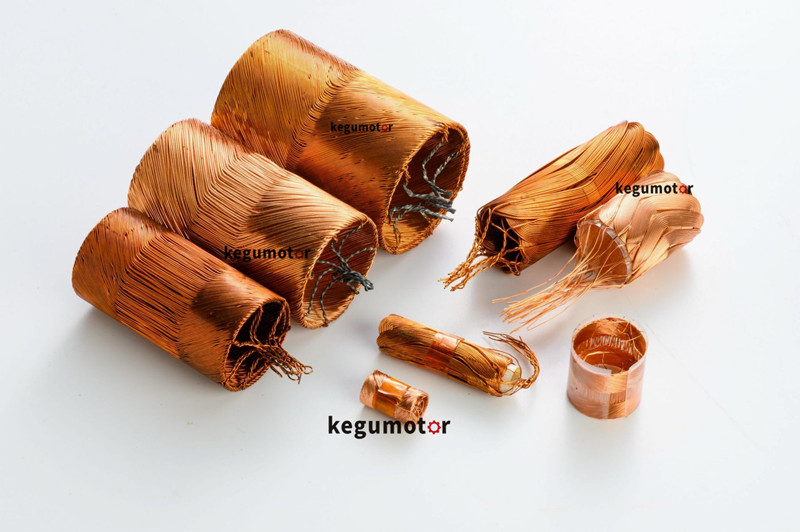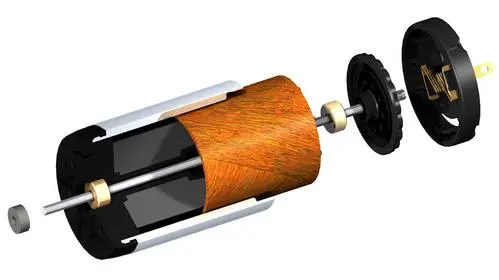
Coreless armature brushed DC permanent magnet motors and slotless brushless DC permanent magnet motors are micro motors for precision instruments. The main advantages of coreless armature brushed DC permanent magnet motors are:
① The permanent magnets are usually placed on the inner stator, with a compact structure; in a closed magnetic circuit, the length of the permanent magnet along the magnetization direction accounts for a high proportion relative to the total magnetic circuit length, the leakage flux is small, the air gap flux density is high, and the power density is relatively high.
② The commutation circuit has a small inductance, small commutation sparks, small electromagnetic interference, and good electromagnetic compatibility (EMC) performance.
③ There are no teeth on the soft magnetic core, and the air gap permeability is uniform, so there is no cogging effect torque between the stator and rotor due to the interaction between the teeth and the magnetic poles, and the rotor has no tendency to stay in those spatial positions with large air gap permeability; the linearity of the mechanical characteristics is good, and it can be stable at low speeds. Smooth rotation, easy to control; no shaking, small vibration and low noise during operation.
④ Low moment of inertia, small electromechanical time constant, which can be as low as 1 millisecond, wide bandwidth, fast response and good servo control performance.
⑤ There is no magnetic saturation problem of the core tooth layer, the armature reaction has little effect on the main magnetic field, and the air gap flux density is constant, so the electromagnetic torque and the current input to the motor can maintain a positive proportional relationship.
⑥ There is no core loss, the no-load current is small, generally less than 50 mA, and the operating efficiency is high. ⑦ Long service life. Of course, it also has shortcomings, such as the small heat capacity of the hollow cup armature, poor heat resistance, poor ability to resist impact loads, and easy deformation after heating. In addition, the small inductance of the armature circuit also has negative effects, such as when the output power of the motor is modulated by pulse width modulation (PWM). When the frequency or speed is controlled, the current reacts very quickly, and current pulsation will appear in the armature winding, which will cause the motor to heat up seriously; at the same time, the fast-changing current reaction will also affect the stability of the current control loop.
Although the slotless brushless DC permanent magnet motor is similar to the three-phase permanent magnet synchronous motor in structure, such as the permanent magnet is placed on the rotor, the three-phase winding is placed on the stator, and the pre-loaded ball bearing is used, it is still very different from the synchronous motor: the power supply will supply power to the three-phase armature winding according to the spatial electrical angular position of the rotor inside the motor, rather than being imposed from the outside; on the contrary, its operating mechanism is very similar to the brushed DC permanent magnet motor with three commutation segments, so it has the same mechanical characteristics as the general brushed DC permanent magnet motor, with high starting Dynamic torque and good dynamic performance.
In addition, its main advantages are:
① Because it uses electronic commutation instead of mechanical commutation, the speed is not limited by the brush/commutator mechanical components and can operate at a speed of up to 100,000 rpm.
② It uses a slotless outer stator core, so it has no cogging torque, runs smoothly, has little vibration and noise.
③ Long service life. Of course, there are some shortcomings in slotless brushless DC permanent magnet motors. For example, its operation is inseparable from the controller. In addition to being used to realize electronic commutation, the controller is also used to control the speed or position of the motor, thereby increasing production costs. At the same time, it increases the reliability of electronic components and electrical circuits; the alternating magnetic flux in the stator core will produce core loss, affecting the operating efficiency of the motor.


Contact: Marketing Department
Phone: +86-18682260827
Tel: 0755-27801762
Email:sales@kegumotor.com
Add: 301, No. 12, Yaming Street, Dongkeng Community, Fenghuang Street, Guangming District, Shenzhen